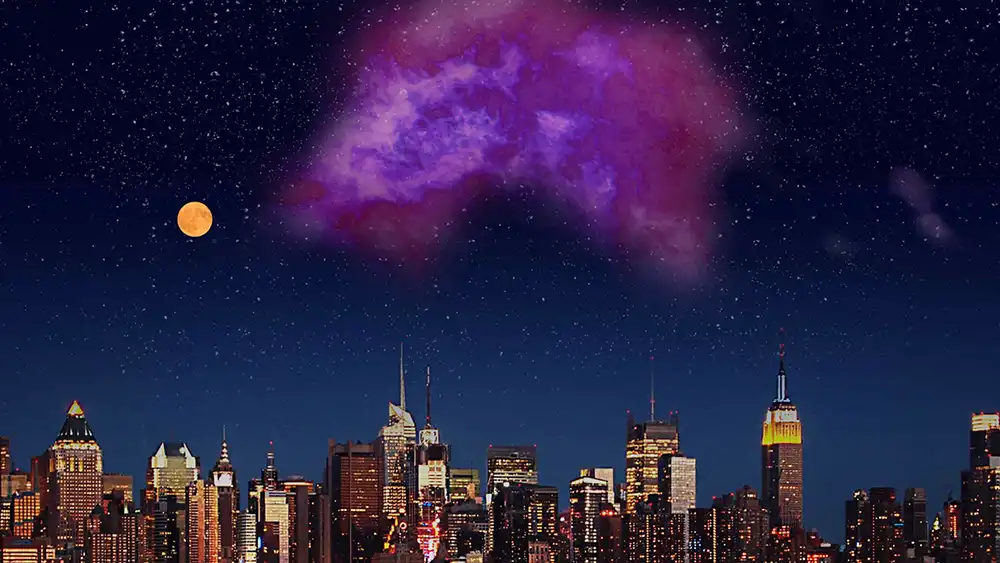Composite image: NatureLifePhoto / Flickr (New York City Skyline); Burkhart et al. 2025
Did you notice something peculiar the last time you gazed at the constellation Corona Borealis, the Northern Crown? Probably not. Yet this part of the sky is home to a cloud of hydrogen molecules that stretches across some 40 times the apparent diameter of the Full Moon. No one knew it was there until now.
The Eos cloud, as the newly discovered structure has been called (after the Greek goddess of dawn), is approximately 100 light-years wide and contains some 5,500 solar masses of cold gas, mostly molecular hydrogen (H2). The densest of such molecular clouds are the birthplaces of stars and planets. With its near side located at just 300 light-years from the Sun, Eos is the molecular cloud closest to us.
“Our discovery of Eos is exciting because we can now directly measure how molecular clouds are forming and dissociating, and how a galaxy begins to transform interstellar gas and dust into stars and planets,” says Blakesley Burkhart (Rutgers University) in a press statement.
Burkhart and her colleagues published their discovery earlier this year in Nature Astronomy. On June 27th, coauthor Thomas Haworth (Queen Mary University London) discussed the result at the 2025 meeting of the European Astronomical Society in Cork, Ireland.
The hydrogen gas in molecular clouds is notoriously difficult to detect, because the molecules are so simple they emit hardly any radiation. That’s why astronomers use the second most abundant molecule, carbon monoxide (CO), as a “tracer”; these molecules emit radiation at a a wavelength of 2.6 millimeters, which radio telescope can detect. However, the Eos cloud contains hardly any CO, which is why it has always escaped detection.
Fortunately, hydrogen does emit some radiation at more energetic wavelengths. The team discovered the cloud in data from the Korean Science and Technology Satellite 1 (STSAT-1). Between 2003 and 2005, the mission’s Far-ultraviolet Imaging Spectrograph (FIMS) mapped large areas of the sky at far-ultraviolet wavelengths. The data became publicly available in 2023.
As Haworth explains, in excited hydrogen molecules, an electron has been boosted to a higher energy state. When that electron comes back down closer to the nucleus, it emits far-ultraviolet radiation in a process called fluorescence. “We don’t know yet what does the exciting,” he says. “It could be cosmic rays or energetic radiation.”
While looking at the FIMS data, Burkhart discovered a weird, crescent-shaped structure that the team later named Eos. Subsequent studies of dust extinction (among other techniques) revealed the cloud’s distance and mass.
“It was rather unexpected that a molecular cloud so close to the Sun could have been completely missed,” says Haworth.
Many molecular clouds (like the one in Orion, for instance) spawn new stars, as bits of the clouds’ gas and dust collapse under their own gravity. However, the Eos cloud appears to be too warm to allow such gravitational collapse.
Indeed, at the Cork meeting, Haworth presented a new analysis of data from the Gaia spacecraft, which is mapping out more than 1 billion Milky Way stars. The analysis, to be published in Monthly Notices of the Royal Astronomical Society, suggests no new stars have formed in this part of the sky over the past tens of millions of years.
Neither will the cloud experience substantial star formation in the future. Eos’s crescent shape appears to be the result of interaction with a plume of hot gas known as the North Polar Spur, which extends upward from the central plane of the Milky Way. Within 6 million years or so, soft X-rays from the North Polar Spur will likely break Eos’s hydrogen molecules apart, dispersing the cloud.
This summer, Haworth and his colleagues will submit a proposal to NASA for a small ultraviolet spectroscopy mission — also called Eos — that would shed more light on the formation and dissociation of molecular clouds. “There are likely other CO-dark clouds out there to discover,” he says.

